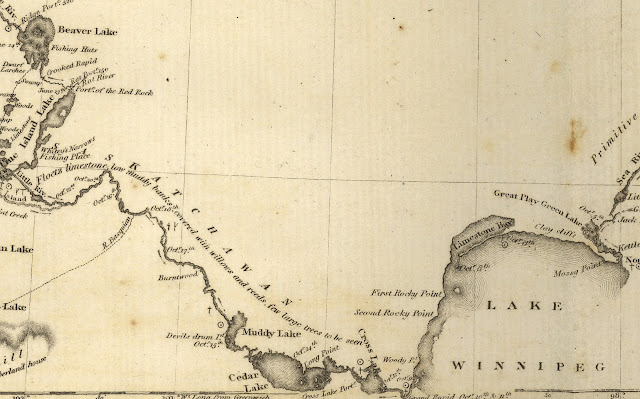 |
| York boat and crew at Fort Edmonton Park |
"The sight of us on the Saskatchewan caused a general alarm among the “Savanais” camped on the left bank. From far away as soon as these Indians saw us coming, they ran in all directions, dragging by the gills or carrying on their naked backs huge sturgeons. They hurried to hide their catch from the Metis who were starved for fish.
However swift they were in hiding from us their catch they had been seen. In my eyes this panic put into question the honesty of the boat crews.
-Ah! Look at them, cried the angry Metis. See how they run carrying their fish into the woods.
We will make you give them up, your sturgeons, just you wait a little while, my boys.
Saying this, they quickened their rowing to get to the tents before their women had completely emptied them. Along the shore, aligned like penguins, the men of the camp waited for us with long poles in their hand.
-Are they going to attack us, perhaps, with their lances? I asked our guide. He started laughing.
-No Father; they want to sell us these poles for our use in the rapids. They do this every time we pass. We are always assured of good poles when we pass this village.
-That’s good! Does that mean you won’t get any fish.
-We will see. Instead of food they have just poles to offer, that’s too much! And us who carry their ammunition and dry goods that the Hudson’s Bay Company gives them! Ah! well, they are too miserly these ‘Savanais’. We’ll have to teach them some manners.
Suddenly, the boats went up to the shore, and the Metis, without looking at the poles being offered, ran up the incline of the high shoreline and in all directions chased the hysterical women. In vain, the ‘Savanais’ protested that they had nothing and had no fish to sell; but soon, the Metis came back with screams of joy and great laughter, carrying by the gills enormous sturgeons, followed by the women of the camp that our less than gallant men had just dispossessed. The women protested but their cries fell on deaf ears.
-Ah! Selfish people! We have never seen you be so sneaky. You should not have hidden your sturgeons, we would have paid for them.
The good Metis seemed to believe happily that this fish was their due and the ‘Savannais’ women were stealing and hiding them from their greed.
-It’s wrong, what you’re doing, I told our guide. I can’t even look at what’s happening.
-Ah! well, Father, they will catch more. There are lots in the river. It will teach them for the next time. It doesn’t cost them anything!
-But, Michel, if these Indians are miserly, it seems to me we should give them a good example with generosity and hospitality, instead of stealing.
But no one agreed with me. It goes without saying that Grouard and I refused to eat any of their stolen fish, so as to protest to the end the injustice of it." (my translation of pages 229-231)
from ........."En route pour la mer Glaciale" by Father Emile Petitot
 |
| Lake Sturgeon |
Note: This Portage La Loche Brigade, the Lesperance Brigade, with its seven York boats carried 65 men plus perhaps 20 passengers. They could easily overwhelm any of the villages that they passed on the way. This village of Swampy Cree may have had about 50 or 60 people. The second Portage La Loche Brigade of the same size may have passed by just a few days earlier.
 |
| A portion of Sir John Franklin's map of 1819-20
The "Savanais" village was by Grand Rapids near the mouth of the Saskatchewan close to Lake Winnipeg according to the following site.
"Grand Rapids derives its name from the four miles of turbulent rapids through which the Saskatchewan River dropped seventy feet to drain into Lake Winnipeg. For centuries native fishing parties harvested bountiful supplies of sturgeon at the Rapids. In the historic period the natives stood on the rocks beside the deep pools at O nika pik (the Carrying Place), moved a pole slowly downstream through the deep water until they felt the sturgeon’s ridged back-bone, and came back through the water with their scoop to catch the fish. [1] Quantities of fish oil, used for subsistence and for trade, were made from the catch. The whitefish were also caught in scoop nets, smoked and dried, and then pounded over rocks to produce a fish pemmican, suitable for use in winter and on the trail."
"When Pere Emile Petitot passed through Grand Rapids in 1863 (*1862), he saw a large camp of Savanais (Swampy Cree) on the south shore of the Saskatchewan River, near Lake Winnipeg."
http://www.mhs.mb.ca/docs/mb_history/15/thunderingwatersstilled.shtml
Note: A dam was built by Grand Rapids in the 1960's and the rapids disappeared.
|